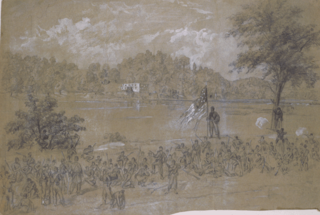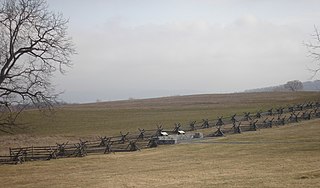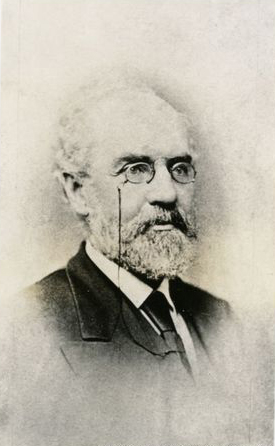
Shepherdstown is a town in Jefferson County, West Virginia, United States, located in the lower Shenandoah Valley along the Potomac River. Home to Shepherd University, the town's population was 1,531 at the time of the 2020 census. The town was established in 1762 along with Romney; they are the oldest towns in West Virginia.

Shepherd University is a public university in Shepherdstown, West Virginia. It is accredited by the Higher Learning Commission. In the fall of 2023, the university enrolled 3,274 students.

The Battle of Shepherdstown, also known as the Battle of Boteler's Ford, took place September 19–20, 1862, at Boteler's Ford along the Potomac River, during the Maryland campaign of the American Civil War. After the Battle of Antietam on September 17, General Robert E. Lee and the Confederate Army of Northern Virginia withdrew across the Potomac. Lee left a rear guard commanded by Brigadier General William N. Pendleton at Boteler's Ford. On September 19, elements of the Union V Corps dueled with Pendleton's artillery before pushing a short distance across the river at dusk. Pendleton inaccurately informed Lee that all of the artillery of the rear guard had been captured. On the morning of September 20, the Confederates counterattacked with A. P. Hill's Light Division, forcing the Union units back across the Potomac. One Union unit, the 118th Pennsylvania Infantry Regiment, did not withdraw at the same time as the others and suffered heavy losses. Lee's army continued its retreat into the Shenandoah Valley after the battle.

Antietam National Battlefield is a National Park Service-protected area along Antietam Creek in Sharpsburg, Washington County, northwestern Maryland. It commemorates the American Civil War Battle of Antietam that occurred on September 17, 1862.

The U.S. state of West Virginia was formed out of western Virginia and added to the Union as a direct result of the American Civil War, in which it became the only modern state to have declared its independence from the Confederacy. In the summer of 1861, Union troops, which included a number of newly formed Western Virginia regiments, under General George McClellan drove off Confederate troops under General Robert E. Lee at the Battle of Philippi in Barbour County. This essentially freed Unionists in the northwestern counties of Virginia to form a functioning government of their own as a result of the Wheeling Convention. Before the admission of West Virginia as a state, the government in Wheeling formally claimed jurisdiction over all of Virginia, although from its creation it was firmly committed to the formation of a separate state.
The 7th West Virginia Infantry Regiment was an infantry regiment that served in the Union Army during the American Civil War. For much of the war, it was a part of the famed "Gibraltar Brigade" in the Army of the Potomac. It was famed primarily for two major actions, a determined attack on the Sunken Road at Antietam and a late evening counterattack on East Cemetery Hill at Gettysburg that helped push back an attack by the Louisiana Tigers.

Alexander Robinson Boteler was a nineteenth-century planter turned businessman, as well as artist, writer, lawyer, Confederate officer, philanthropist and politician from Shepherdstown in what was initially Virginia and became West Virginia in the American Civil War.

The Shepherdstown Historic District comprises the historic core of Shepherdstown, West Virginia. The town is the oldest in West Virginia, founded in 1762 as Mecklenburg. No structures are known to exist from the time before the town became known as Shepherdstown. The historic district is concentrated along German Street, the main street, with 386 contributing resources and 69 non-contributing elements. The chief representative period is the late 18th century, with many Federal style brick houses. German Street is also furnished with 19th-century "street furniture" such as metal fences, mounting blocks, wooden pumps and mature trees.

The Conrad Shindler House is a historic building, now home to the George Tyler Moore Center for the Study of the Civil War, in Shepherdstown, West Virginia.

The 13th Virginia Infantry Regiment was an infantry regiment raised in central and western Virginia for service in the Confederate States Army during the American Civil War. It fought mostly with the Army of Northern Virginia.

The 59th Virginia Infantry Regiment was an infantry regiment raised in Virginia's western counties for service in the Confederate States Army during the American Civil War. It fought mostly with the Army of Northern Virginia, and in the Carolinas.

The 62nd Virginia Mounted Infantry Regiment, raised in Virginia for service in the Confederate States Army during the American Civil War, served in many capacities including the war, including as an infantry regiment, a cavalry regiment, a mounted infantry (dragoon) unit, a partisan unit of rangers, and even as a combined arms unit. It fought mostly with the Army of Northern Virginia and in western Virginia. The men were recruited primarily in the counties of Hardy, Hampshire, Barbour, Pendleton and Pocahontas in West Virginia and Augusta and Highland in Virginia .

The 10th Virginia Cavalry Regiment was a cavalry regiment raised in Virginia for service in the Confederate States Army during the American Civil War. It fought mostly with the Army of Northern Virginia.

The 11th Virginia Cavalry Regiment was a cavalry regiment raised in Virginia for service in the Confederate States Army during the American Civil War. It fought mostly with the Army of Northern Virginia.

The 14th Virginia Cavalry Regiment was a cavalry regiment raised in Virginia for service in the Confederate States Army during the American Civil War. The regiment was organized during September 1862, with nine companies, some of which had previously served in Jackson's Squadron Virginia Cavalry. The tenth company was made up of surplus men of the other companies. The men were recruited primarily from the counties of Greenbrier, Nicholas, Calhoun, Boone, Braxton, Roane, Jackson, Wirt, and Wood in what would become West Virginia, and the Virginia counties of Charlotte, Roanoke, Montgomery, Augusta, Rockbridge and Highland.

The 23rd Virginia Cavalry Regiment was a cavalry regiment raised in Virginia for service in the Confederate States Army during the American Civil War. The regiment was recruited primarily in the counties of Hampshire, Hardy, Morgan, Berkeley, Frederick, Clarke, Shenandoah, Warren, Rockingham, Augusta, Allegheny and Henrico. It fought in the Shenandoah Valley.

The Heyward Shepherd monument is a monument in Harpers Ferry, West Virginia, dedicated in 1931. It commemorates Heyward Shepherd, a free black man who was the first person killed during John Brown's raid on Harpers Ferry.
Alva Dayne Kenamond was an American university professor, administrator, and college football coach from West Virginia. He served as the dean of Shepherd University from 1924 to 1928, and the head football coach at West Liberty State Normal School (1906–1912) and Shepherd University (1920). Kenamond also served as a West Virginia Court of Claims judge from 1950 to 1954.

The Wise Artillery was an artillery unit with the Confederate States Army during the American Civil War.

John Henry Hill was an American lawyer, educator, school administrator, and military officer. He was the second principal of the West Virginia Colored Institute from 1894 until 1898. West Virginia State considers him its second president.














